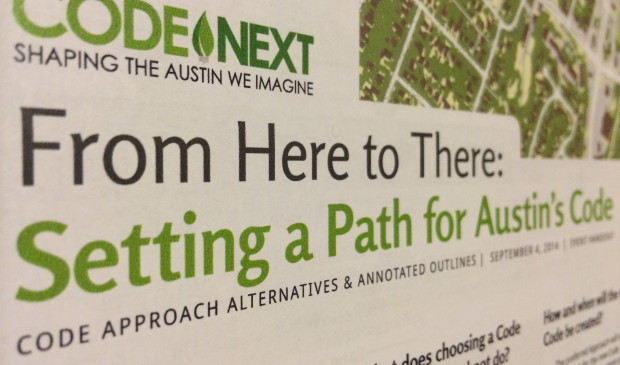CodeNEXT prescription papers scrutinized at Planning Commission
Friday, October 14, 2016 by
Joseph Caterine CodeNEXT Advisory Group members Dave Sullivan and Colby Wallis – joined by city staff members Annick Beaudet, Ashley Greenstein and Paul DiGiuseppe – were met with skeptical looks when they presented the final two CodeNEXT prescription papers at this week’s Planning Commission meeting.
The two papers – about mobility and fiscal health – followed previous prescription presentations on the environment and affordable housing, and they signal a wrapping-up of the drafting process, with the official draft code to be released in January.
Both papers focus on the mounting infrastructure costs of Austin’s growth and argue that the main solution to this problem is a rewrite of city code to align land use with higher density goals. “Density isn’t the only component of a community,” DiGiuseppe told the Austin Monitor. “But a more walkable community with more households and more people does improve service efficiency.”
For mobility, Sullivan and Beaudet talked about using the Land Development Code to place the sought-after density along the transit corridors outlined in the Imagine Austin comprehensive plan. They recommended making changes to the code that would more strictly enforce connectivity, including the addition of connectivity requirements for remodeling applications and variance requirements that are less lenient than at present. They also discussed updating the transportation impact analysis process as well as introducing street impact fees as a way to direct connection-centered growth.
During the fiscal health presentation, Greenstein highlighted the dilemma of depending on private investment for new developments while not knowing what the maintenance and service costs of those projects will be in the future. She suggested that land-use requirements designed around districts rather than the uniform model of the current code would make these costs more predictable.
Presenters also emphasized the need for clearer and better subdivision standards that, among other benefits, would curb the trend of cul-de-sacs becoming “publicly funded private drives,” according to Wallis. Having the right subdivision standards, he said, will align with the strategy of growth paying for growth.
In terms of funding projects within these guidelines, DiGiuseppe recommended public-private partnerships. However, when Commissioner Trinity White asked for staff to elaborate on how those partnerships would be formed, no one could provide an answer.
Sarah Behunek, a public information specialist with the Capital Planning Office, told the Monitor that the city currently has a variety of public-private partnerships but there is no formal policy to steer them. “There aren’t exactly established guidelines,” she said.
Some commissioners felt that the Planning Commission had been left out of the CodeNEXT drafting process. “There were promises made in January that you would provide us with more information,” said Commissioner Patricia Seeger. “I’m disappointed that you all have not followed through on that.”
“We are working on including different stakeholders, and the Planning Commission is definitely an important one,” DiGiuseppe told the Monitor.
Near the end of the discussion, Commissioner Nuria Zaragoza asked if the prescription papers include considerations for people who would be displaced by increased density along the corridors. Jonathan Tomko from the Neighborhood Planning and Community Development Department offered the metaphor of musical chairs. “If we are not adding more chairs into the mix,” he said, “then people will have nowhere to sit.”
“But that is not what is happening,” Zaragoza responded. “We are replacing old chairs with plush couches!”
When the draft code is released in January, there will be a six-month public review process, followed by an adoption process that will require approval from the Planning Commission. Prior to that, it is unclear when the commission will get another look.
The Austin Monitor’s work is made possible by donations from the community. Though our reporting covers donors from time to time, we are careful to keep business and editorial efforts separate while maintaining transparency. A complete list of donors is available here, and our code of ethics is explained here.
You're a community leader
And we’re honored you look to us for serious, in-depth news. You know a strong community needs local and dedicated watchdog reporting. We’re here for you and that won’t change. Now will you take the powerful next step and support our nonprofit news organization?




